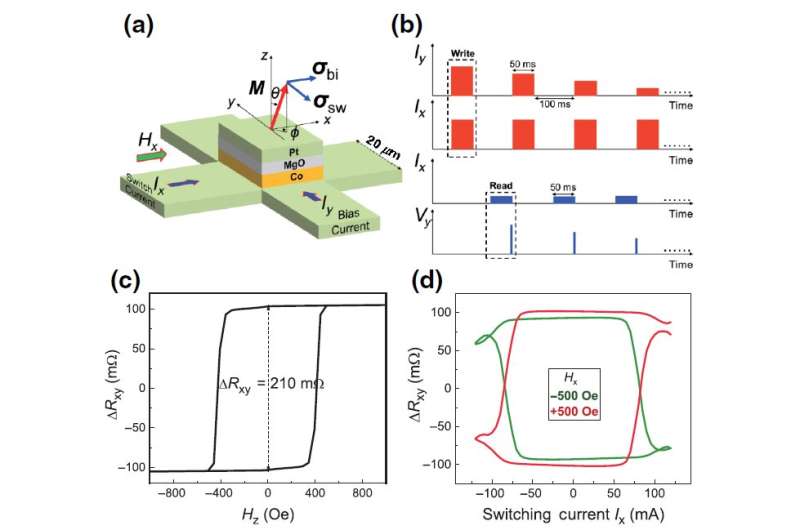Measurement setup and type-z SOT switching. (a) Crossbar geometry with Ix, Iy , σsw, and σbi inside. (b) Nonvolatile measurement sequence. Write and read processes are separated in the time domain. (c) Anomalous Hall resistance Rxy as a function of Hz . The maximum _Rxy = 210 m_. (d) SOTinduced magnetization switching with a bias field Hx of 500 Oe. Opposite Hx leads to opposite switching chirality. Credit: FEFU press office
Scientists of Far Eastern Federal University (FEFU, Vladivostok, Russia) together with colleagues from the Chinese Academy of Sciences (Beijing) have designed a platinum-cobalt-magnesium oxide microstructure coated by platinum that is capable of operating in three-valued logic mode (true/false/don't know). It paves the way for building new electronic and spintronic devices, qutrit quantum processors (three positions instead of two of qubits), and neuromorphic systems imitating human brain activity. A related article is published in Physical Review Applied.
Contemporary computer processors consume a lot of energy, represent different compartments with memory cells, and their efficacy is limited by two-valued logic (true/false). These three obstacles curb further development of computer devices on the way to miniaturization and fast performance.
Within a joint project of the Russian Foundation for Basic Research (RFBR) and the Chinese Academy of Sciences, scientists from School of Natural Sciences, FEFU, developed a cross-shaped microstructure consisting of nanometer layers of platinum, cobalt (just 0.8 nm), magnesium oxide, and a coating layer of platinum.
The structure can be a single platform performing simultaneously as a processor and a memory chip. This feature can contribute to the miniaturization of devices implemented on the platform. It could be applied in electronic and spintronic devices operating on the three-valued logic, including qutrit quantum processors (three-level system instead of two-level qubits), and neuromorphic systems that mimic the functionality of the human brain.
"Due to a certain sequence of layers and switching of the electron spins in the lower platinum layer, we are able to effectively control three magnetic states in the cobalt layer. These states correspond to of the three-valued logic modes which are -1, 1 and 0 or true, false, don't know, in the terms of regular language. Three-valued logic (Aristotle's logic) is far superior to binary, Boolean logic (0/1). Its principles set the foundation for intelligent computers in the near future. These new devices will have a higher performance, longer life span, and lower energy consumption compared to devices built upon other principles," said Alexander Samardak, project manager from the Russian side, associate professor of computer systems at the FEFU School of Natural Sciences.
To obtain the spin current and affect the cobalt layer, the scientists applied two cross-currents and an in-plane magnetic field to shift magnetic symmetry. At the same time, they induced a short-impulse current passing through the lower layer of platinum. As a result, the spins of electrons with different polarity (oriented "up" and "down," corresponding to the modes 1 and 0) turned to opposite surfaces of the platinum layer, producing a pure spin current that affected the spins of the electrons of the magnetic layer. Under certain conditions, spins of the cobalt layer were switched. It meant the cell switched from 0 to 1 in analogy.
Due to current pulses, which were passed through two other orthogonally (perpendicularly) located contacts, it was possible to control different magnetic states in the cobalt layer, thus implementing different states of the three-valued logic. It turned out that such orthogonal currents can be lower, and there was an opportunity to control other intermediate stable magnetic states in the layered structure, which is important for the development of neuromorphic devices. Moreover, such logical operations as AND, OR, NOT-AND and NOT-OR can be called in the structure by the means of a certain sequence of cross-currents. It is a more sophisticated and elegant approach than a set of semiconductor gates (transistors, resistors, diodes) that are presently used.
Alexander Samardak explained that in the research paper, the scientists indicated only the tip of the iceberg, and further research is required to achieve real spintronic devices and neuromorphic systems operating on three-valued logic.
First, it is necessary to get rid of the constant magnetic field applied to switch magnetic symmetry. Secondly, it is necessary to reduce the cell size to 100-200 nm in order to implement a high density of the elements on the chip. Thirdly, it is necessary to deliver an accurate reading of different states of the magnetic layer, which requires highly sensitive sensors based on the effect of tunnel magnetoresistance.
The scientists note that the first computer based on three-value logic was developed in the USSR in the early 1960s. A scientific group headed by Professor N. P. Brusentsov (Lomonosov Moscow State University) implemented the project called Setun. However, Setun was not widely recognized, despite a number of its advantages over binary logic operated machines.
For the eight past years, scientists from FEFU laboratory for film technologies have cooperated with colleagues from the Chinese Academy of Sciences, leaders in the field of production and the study of thin-film systems for spintronics. During this time, they have developed several joint projects on magnetic sensors and nanoscale spin systems.
More information: W.L. Yang et al. Chirality-Reversible Multistate Switching via Two Orthogonal Spin-Orbit Torques in a Perpendicularly Magnetized System, Physical Review Applied (2020). DOI: 10.1103/PhysRevApplied.13.024052
Provided by Far Eastern Federal University
























